Complete Solutions to Linked Comprehension of chapter RIGID BODY DYNAMICS 1 of Class 11 book with complete answers and questions
| Class 11 | PHYSICS |
| Chapter | RIGID BODY DYNAMICS 1 |
| CENGAGE PHYSICS | Linked Comprehension |
| Number Of Questions | 28 |
| Academic Year | 2023-24 |
A uniform rod of mass `M = 2 kg` and length `L` is suspended by two smooth hinges `1` and `2` as shown in Fig. A force `F = 4 N` is applied downward at a distance `L//4` from hinge `2`. Due to the application of force `F`, hinge `2` breaks. At this instant, applied force `F` is also removed. The rod starts to rotate downward about hinge `1`. (`g = 10 m//s^(2)`)
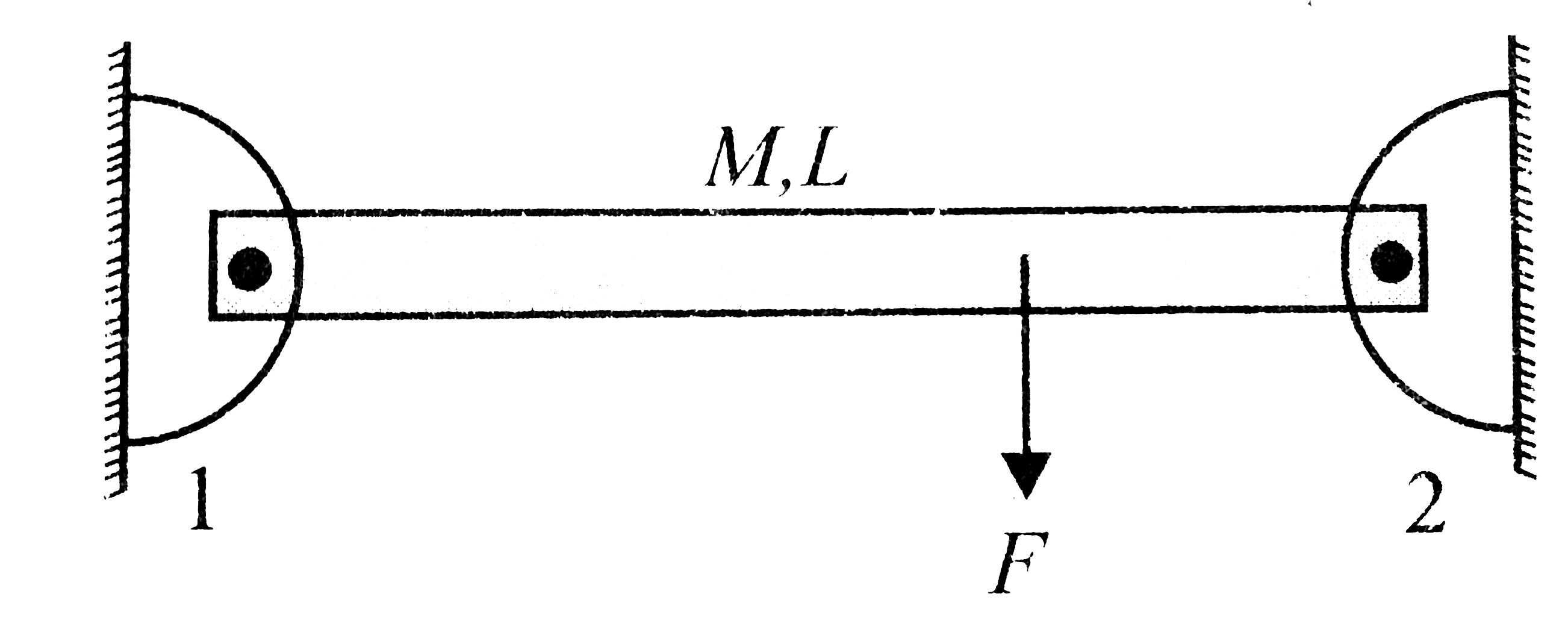
The reaction at hinge `1`, before hinge `2` breaks, is02:35View SolutionA uniform rod of mass `M = 2 kg` and length `L` is suspended by two smooth hinges `1` and `2` as shown in Fig. A force `F = 4 N` is applied downward at a distance `L//4` from hinge `2`. Due to the application of force `F`, hinge `2` breaks. At this instant, applied force `F` is also removed. The rod starts to rotate downward about hinge `1`. (`g = 10 m//s^(2)`)
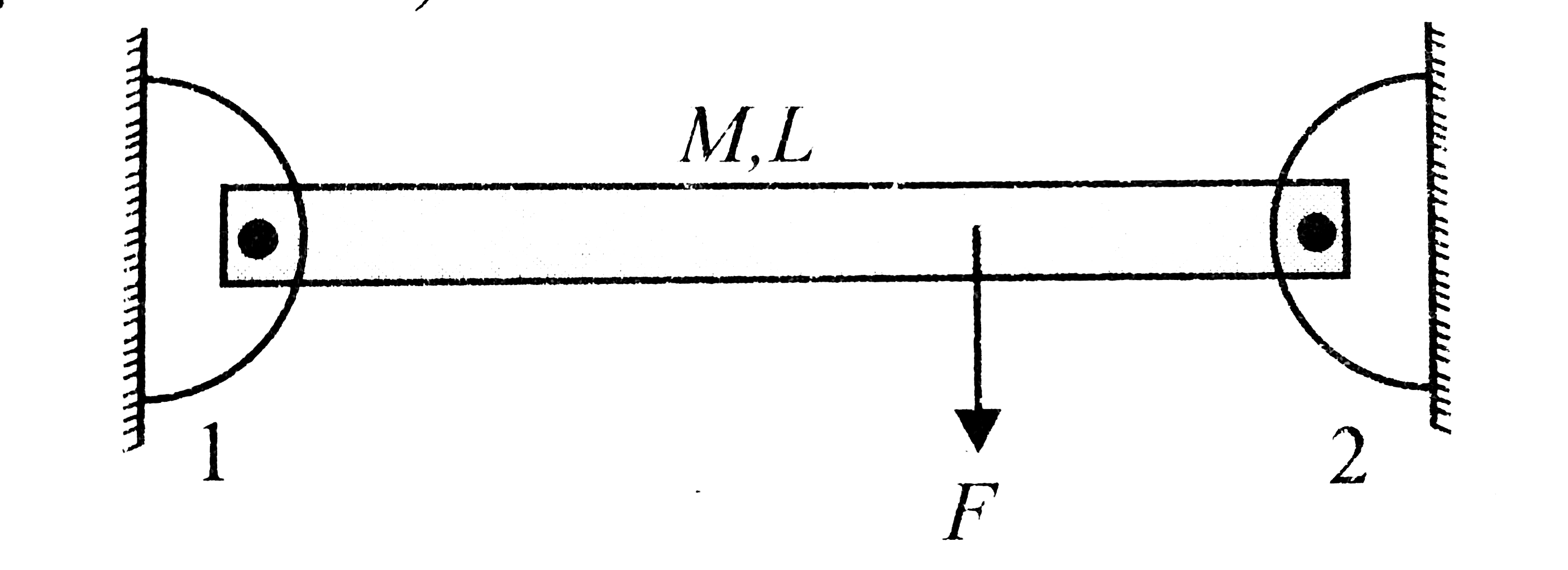
The reaction at hinge `1`, just after breaking of hinge `2`, is03:27View SolutionA uniform rod of mass `M = 2 kg` and length `L` is suspended by two smooth hinges `1` and `2` as shown in Fig. A force `F = 4 N` is applied downward at a distance `L//4` from hinge `2`. Due to the application of force `F`, hinge `2` breaks. At this instant, applied force `F` is also removed. The rod starts to rotate downward about hinge `1`. (`g = 10 m//s^(2)`)

The reaction at hinge `1`, just after breaking of hinge `2`, is03:27View Solution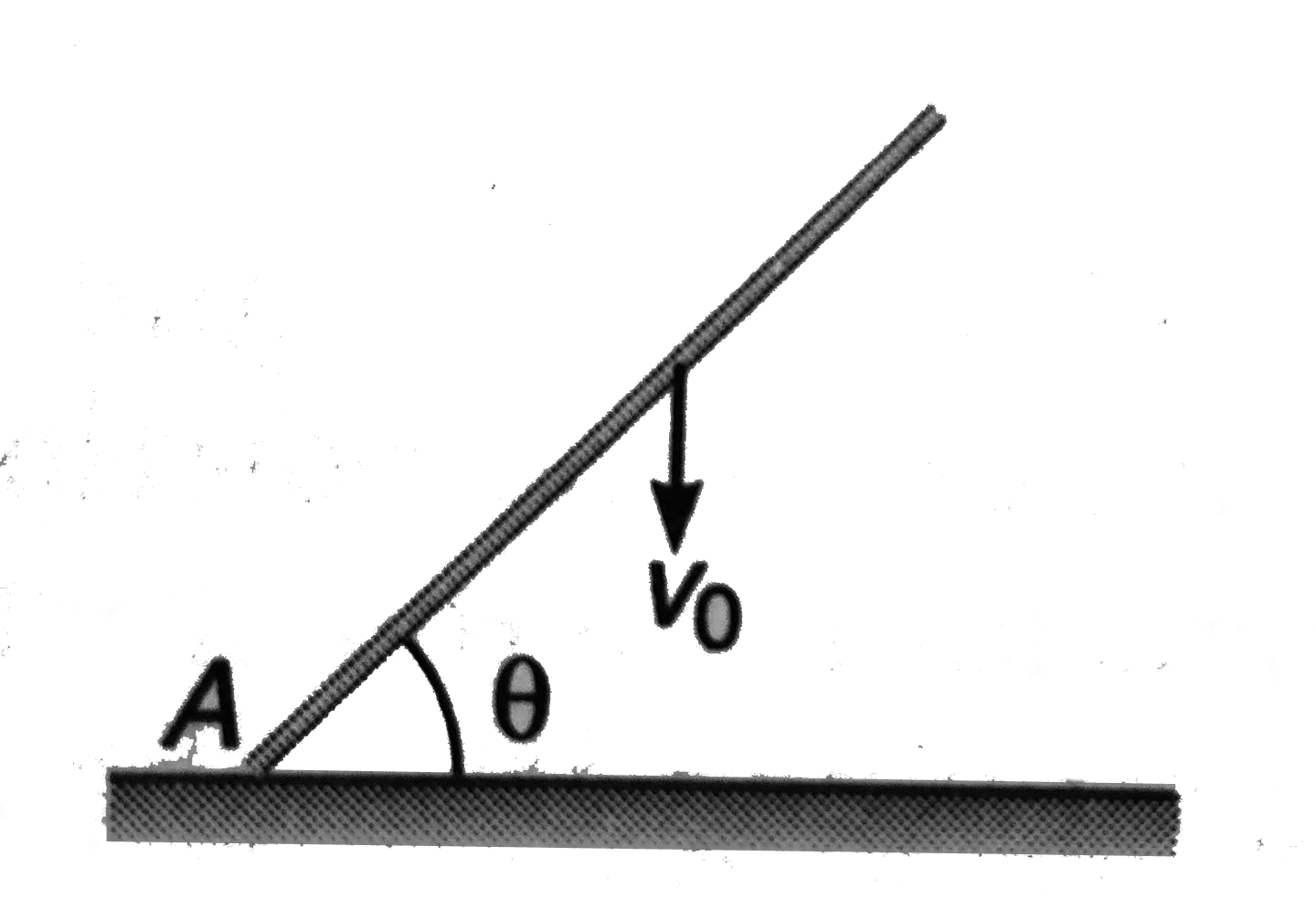
A rod of length `l` forming an angle `theta` with the horizontal strikes a frictionless floor at A with its centre of mass velocity `v_(0)` and no angular velocity. Assuming that the impact at A is perfectly elastic. Find the angular velocity of the rod immediately after the impact.09:05View Solution
The end B of the rod AB which makes angle `theta` with the floor is being pulled with a constant velocity `v_(v)` as shown. The length of the rod is `l`.07:49View Solution- 04:03View Solution
An `L` shaped uniform rod of mass `2M` and length `2L (AB = BC = L)` is held as shown in Fig. with a string fixed between `C` and wall so that `AB` is vertical and `BC` is horizontal. There is no friction between the hinge and the rod at `A`.

Find the tension in the string03:32View SolutionAn `L` shaped uniform rod of mass `2M` and length `2L (AB = BC = L)` is held as shown in Fig. with a string fixed between `C` and wall so that `AB` is vertical and `BC` is horizontal. There is no friction between the hinge and the rod at `A`.
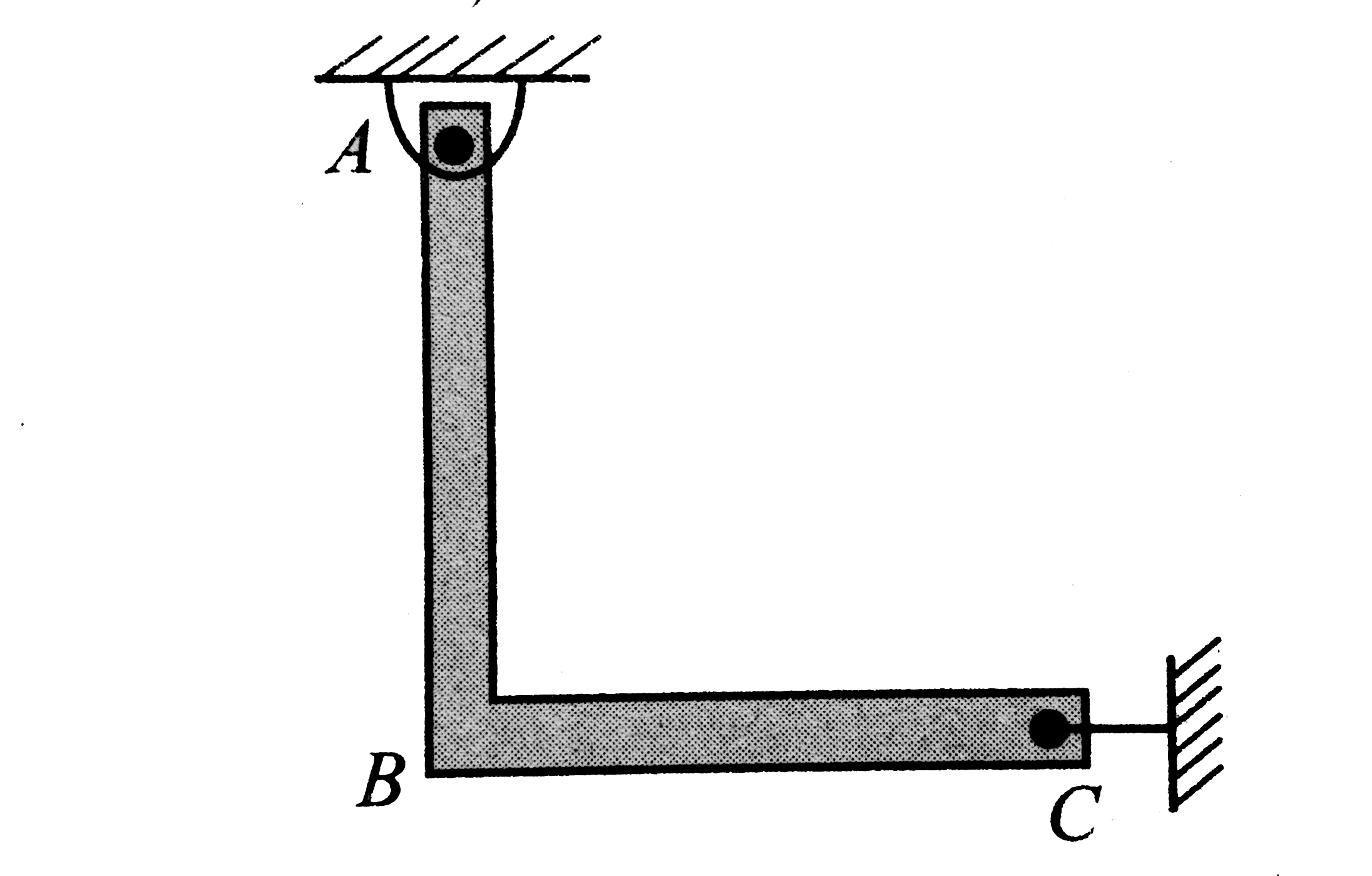 What will be the reaction between hinge and rod at point `A`? 05:23View Solution
What will be the reaction between hinge and rod at point `A`? 05:23View SolutionAn `L` shaped uniform rod of mass `2M` and length `2L (AB = BC = L)` is held as shown in Fig. with a string fixed between `C` and wall so that `AB` is vertical and `BC` is horizontal. There is no friction between the hinge and the rod at `A`.

If the string is burnt, find the angle between `AB` and the vertical at equilibrium position.05:45View SolutionA uniform rod of length `L` and mass `M` is lying on a frictionless horizontal plane and is pivoted at one of its ends as shown in Fig. There is no friction at the pivot. An inelastic ball of mass `m` is fixed with the rod at a distance `L//3` from `O`. A horizontal impulse `J` is given to the rod at a distance `2L//3` from `O` in a direction perpendicular to the rod. Assume that the ball remains in contact with the rod after the collision and impulse `J` acts for a small time interval `/_\t`. Now answer the following questions:

Find the impulse acted on the ball during the time `/_\t`04:21View SolutionA uniform rod of length `L` and mass `M` is lying on a frictionless horizontal plane and is pivoted at one of its ends as shown in Fig. There is no friction at the pivot. An inelastic ball of mass `m` is fixed with the rod at a distance `L//3` from `O`. A horizontal impulse `J` is given to the rod at a distance `2L//3` from `O` in a direction perpendicular to the rod. Assume that the ball remains in contact with the rod after the collision and impulse `J` acts for a small time interval `/_\t`. Now answer the following questions:

Find the impulse acted on the ball during the time `/_\t`04:21View SolutionA uniform rod of length `L` and mass `M` is lying on a frictionless horizontal plane and is pivoted at one of its ends as shown in Fig. There is no friction at the pivot. An inelastic ball of mass `m` is fixed with the rod at a distance `L//3` from `O`. A horizontal impulse `J` is given to the rod at a distance `2L//3` from `O` in a direction perpendicular to the rod. Assume that the ball remains in contact with the rod after the collision and impulse `J` acts for a small time interval `/_\t`. Now answer the following questions:

Find the magnitude of the impulse applied on the pivot during the time interval `/_\t`07:55View SolutionA bicycle has pedal rods of length `16 cm` connected to sprocketed disc of radius `10 cm`. The bicycle wheels are `70 cm` in diameter and the chain runs over a gear of radius `4cm`. The speed of the cycle is constant and the cyclist applies `100 N` for, that is always perpendicular to the pedal rod, as shown in figure. Assume tension in the lower part of chain is negligible. The cyclist is peddling at a constant rate of two revolutions per second. Assume that the force applied by other foot is zero when one foot is exerting `100 N` force. Neglect friction within cycle parts and the rolling friction.
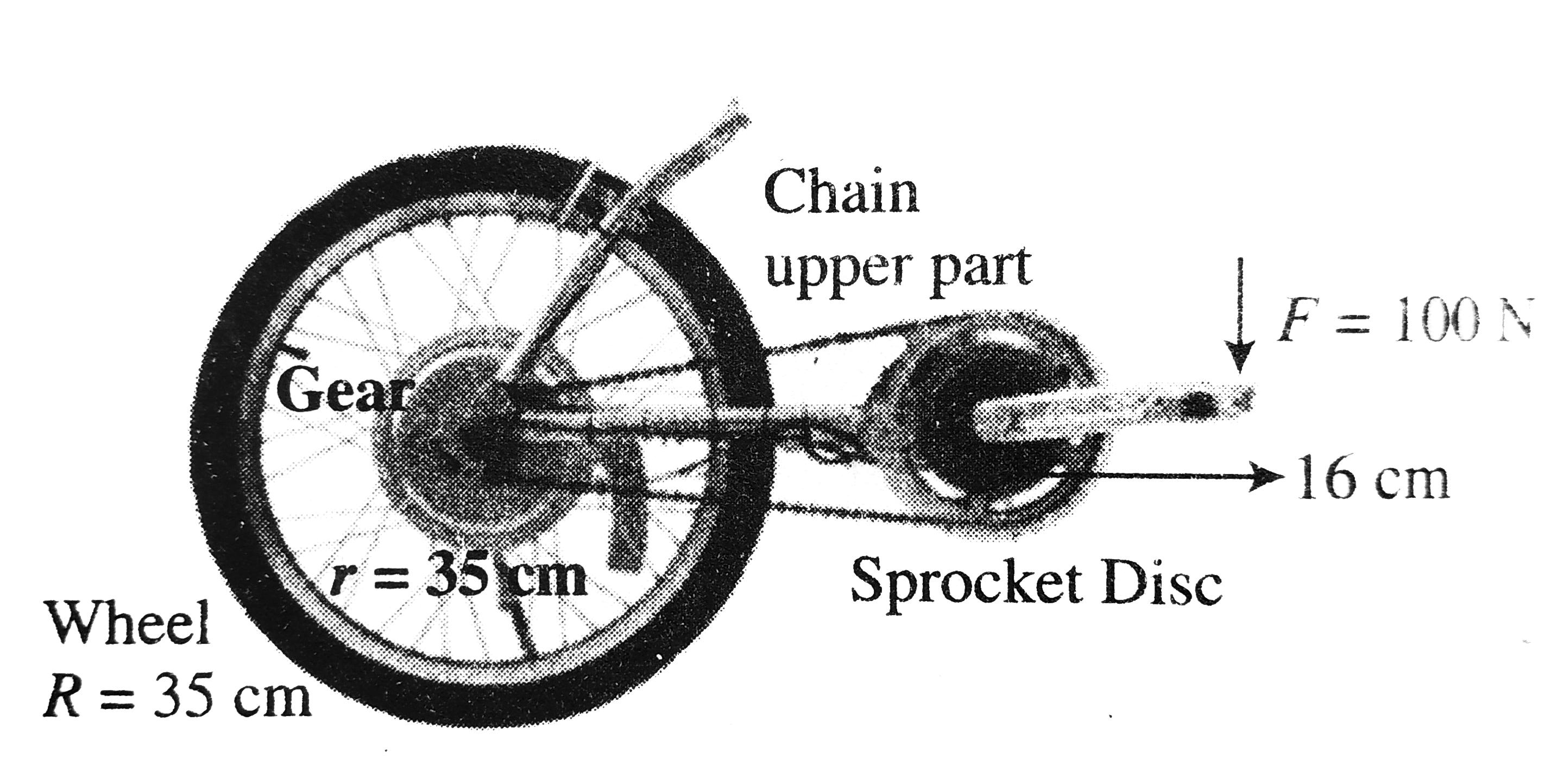
The tension in the upper portion of the chain is equal to03:23View SolutionA bicycle has pedal rods of length `16 cm` connected to sprocketed disc of radius `10 cm`. The bicycle wheels are `70 cm` in diameter and the chain runs over a gear of radius `4cm`. The speed of the cycle is constant and the cyclist applies `100 N` for, that is always perpendicular to the pedal rod, as shown in figure. Assume tension in the lower part of chain is negligible. The cyclist is peddling at a constant rate of two revolutions per second. Assume that the force applied by other foot is zero when one foot is exerting `100 N` force. Neglect friction within cycle parts and the rolling friction.

The speed of the bicycle is03:26View SolutionA bicycle has pedal rods of length `16 cm` connected to sprocketed disc of radius `10 cm`. The bicycle wheels are `70 cm` in diameter and the chain runs over a gear of radius `4cm`. The speed of the cycle is constant and the cyclist applies `100 N` for, that is always perpendicular to the pedal rod, as shown in figure. Assume tension in the lower part of chain is negligible. The cyclist is peddling at a constant rate of two revolutions per second. Assume that the force applied by other foot is zero when one foot is exerting `100 N` force. Neglect friction within cycle parts and the rolling friction.
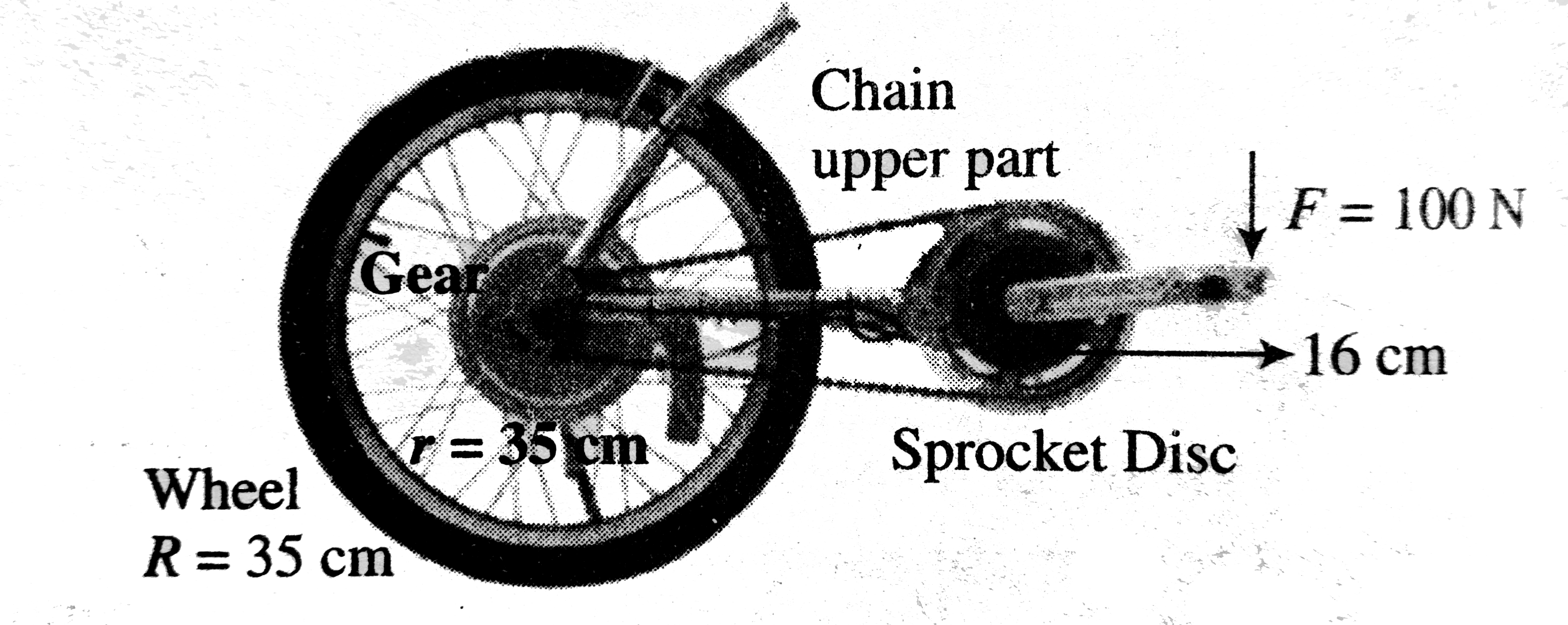
The power delivered by the cyclist is equal to02:13View SolutionA bicycle has pedal rods of length `16 cm` connected to sprocketed disc of radius `10 cm`. The bicycle wheels are `70 cm` in diameter and the chain runs over a gear of radius `4cm`. The speed of the cycle is constant and the cyclist applies `100 N` for, that is always perpendicular to the pedal rod, as shown in figure. Assume tension in the lower part of chain is negligible. The cyclist is peddling at a constant rate of two revolutions per second. Assume that the force applied by other foot is zero when one foot is exerting `100 N` force. Neglect friction within cycle parts and the rolling friction.

The speed of the bicycle is03:26View SolutionA bicycle has pedal rods of length `16 cm` connected to sprocketed disc of radius `10 cm`. The bicycle wheels are `70 cm` in diameter and the chain runs over a gear of radius `4cm`. The speed of the cycle is constant and the cyclist applies `100 N` for, that is always perpendicular to the pedal rod, as shown in figure. Assume tension in the lower part of chain is negligible. The cyclist is peddling at a constant rate of two revolutions per second. Assume that the force applied by other foot is zero when one foot is exerting `100 N` force. Neglect friction within cycle parts and the rolling friction.
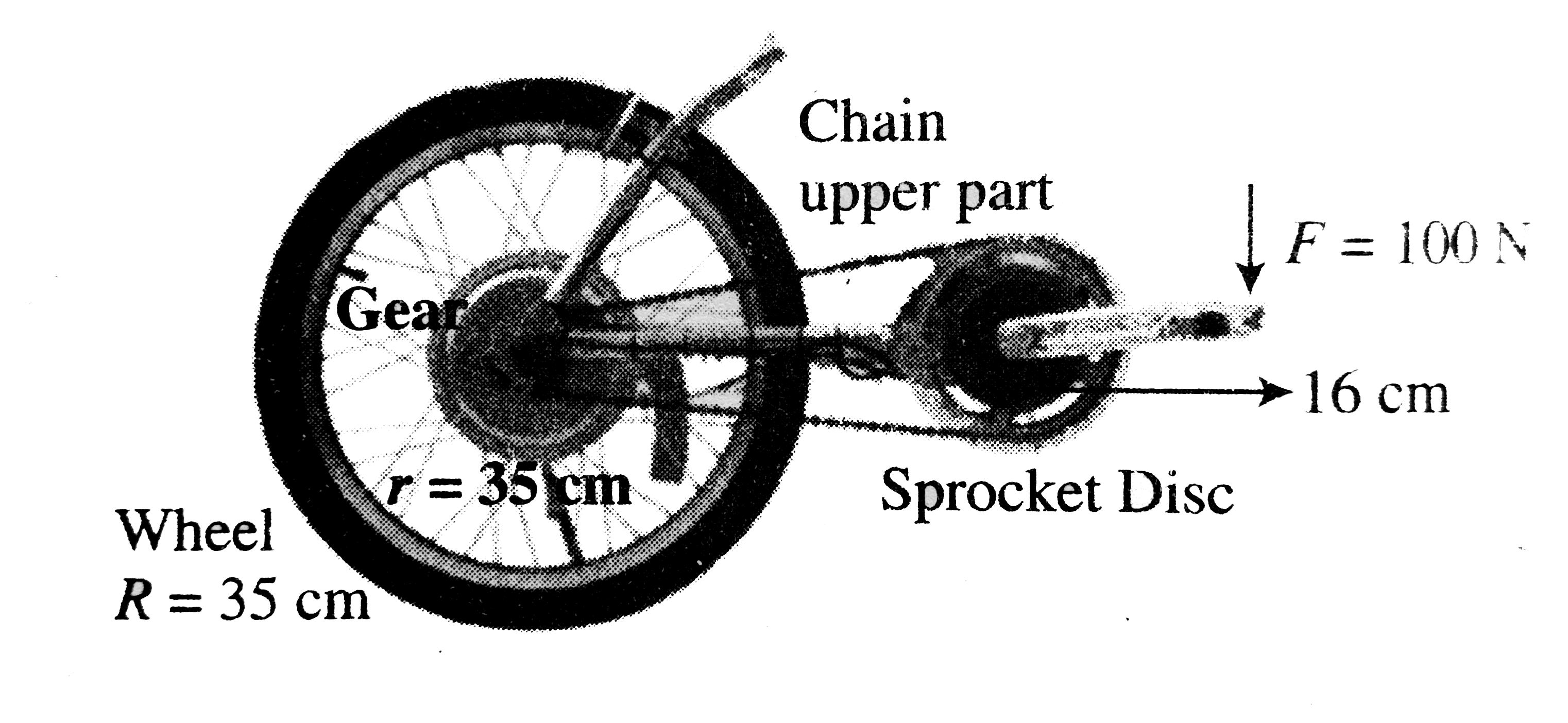
The net force of the friction on the rear wheel due to the road is:03:22View SolutionA cord is wound round the circumference of a solid cylinder radius `R` and mass `M`. The axis of the cylinder is horizontal. A weight `mg` is attached to the end of the cord and falls from rest. After falling through a distance `h`.
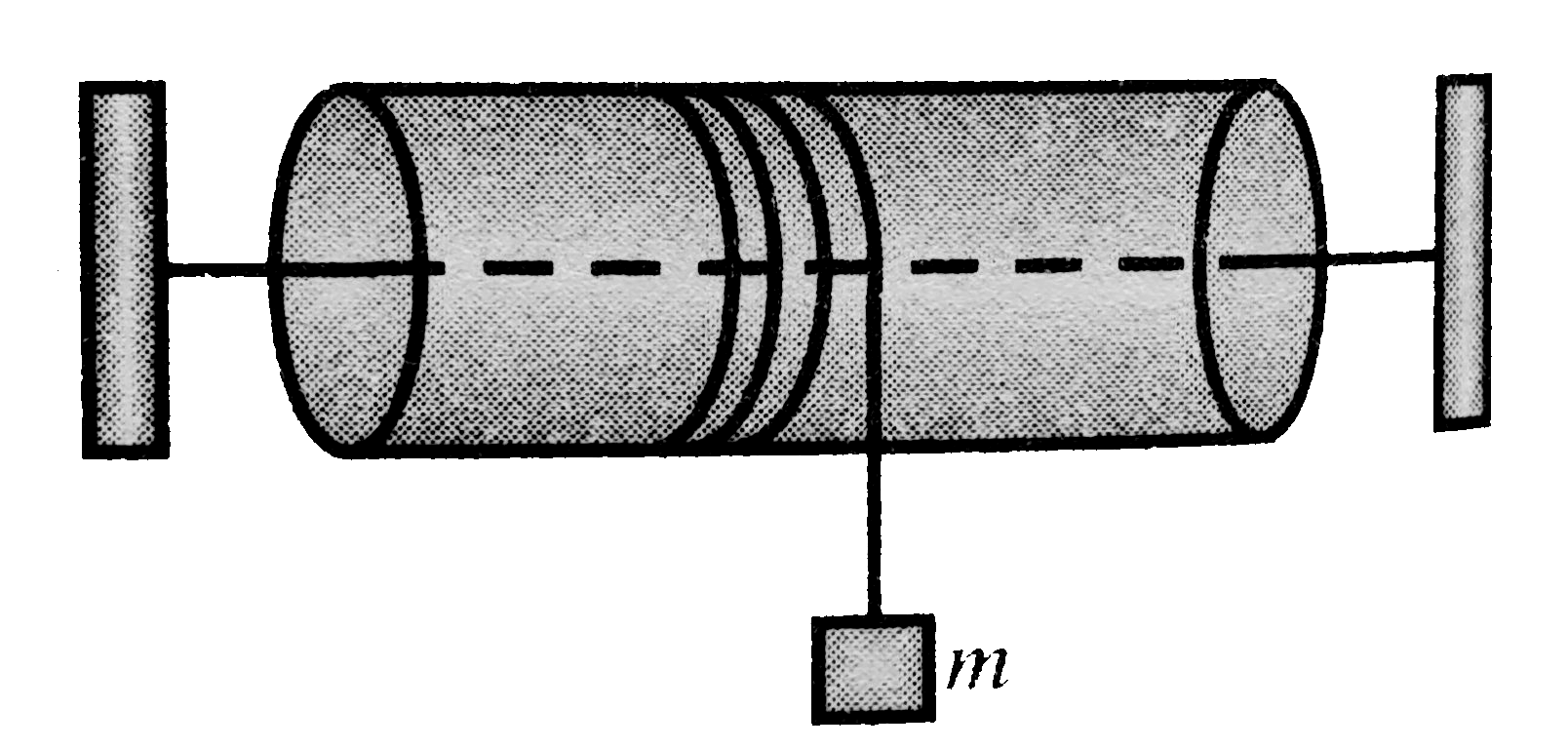
If the mass starts from rest and falls a distance `h`, then its speed at that instant is:02:45View SolutionA cord is wound round the circumference of a solid cylinder radius `R` and mass `M`. The axis of the cylinder is horizontal. A weight `mg` is attached to the end of the cord and falls from rest. After falling through a distance `h`.

If the mass starts from rest and falls a distance `h`, then its speed at that instant is:02:45View SolutionA diving board `3.00 m` long is supported at a point `1.00 m` from the end and a diver weighing `500 N` stands at the free end. The diving board is of uniform cross section and weighs `280 N`. Find.

The force at the support point01:14View SolutionA diving board `3.00 m` long is supported at a point `1.00 m` from the end and a diver weighing `500 N` stands at the free end. The diving board is of uniform cross section and weighs `280 N`. Find.
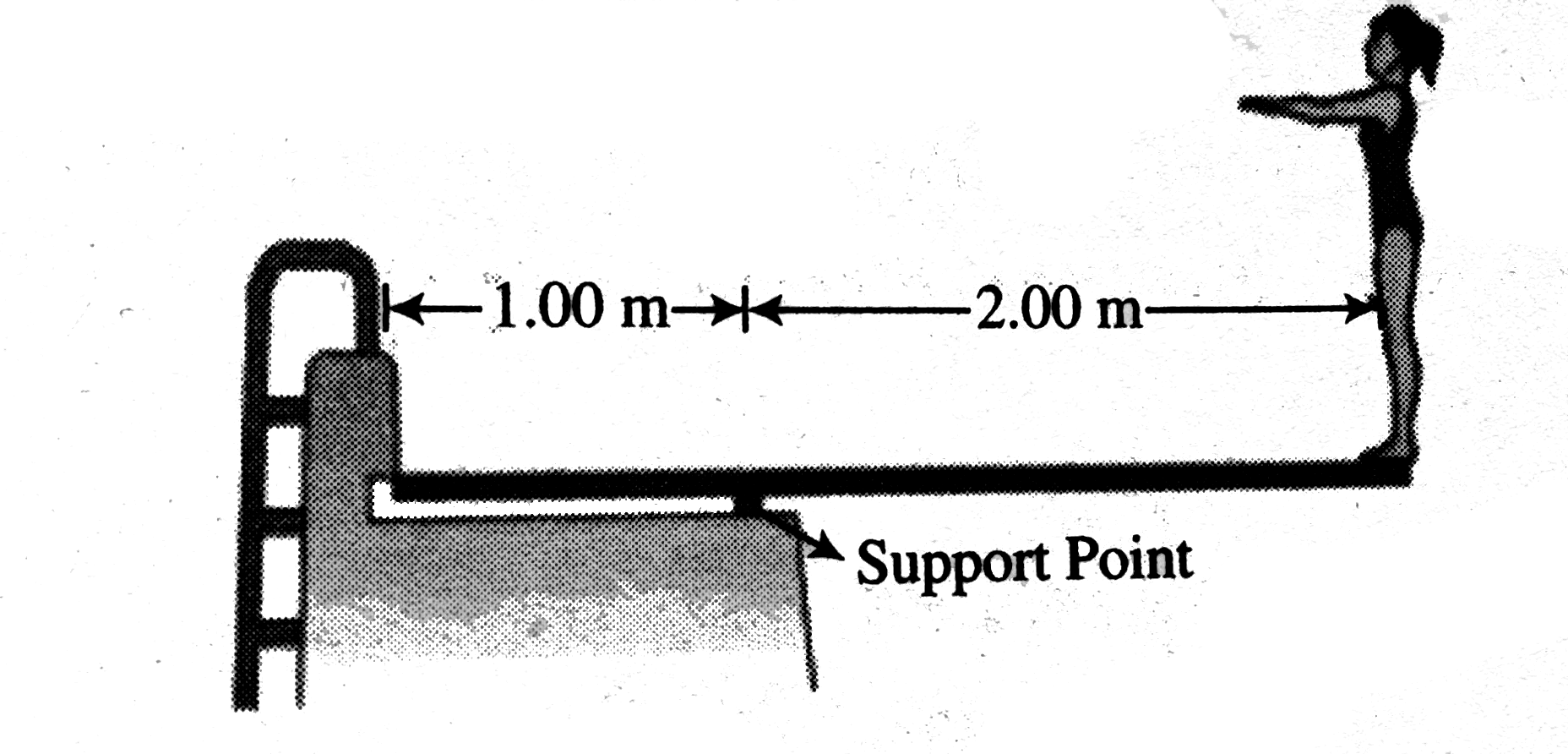
The force at the end that is held down.03:15View SolutionThe horizontal beam in figure weighs `150 N`, and its centre of gravity is at its centre. Find
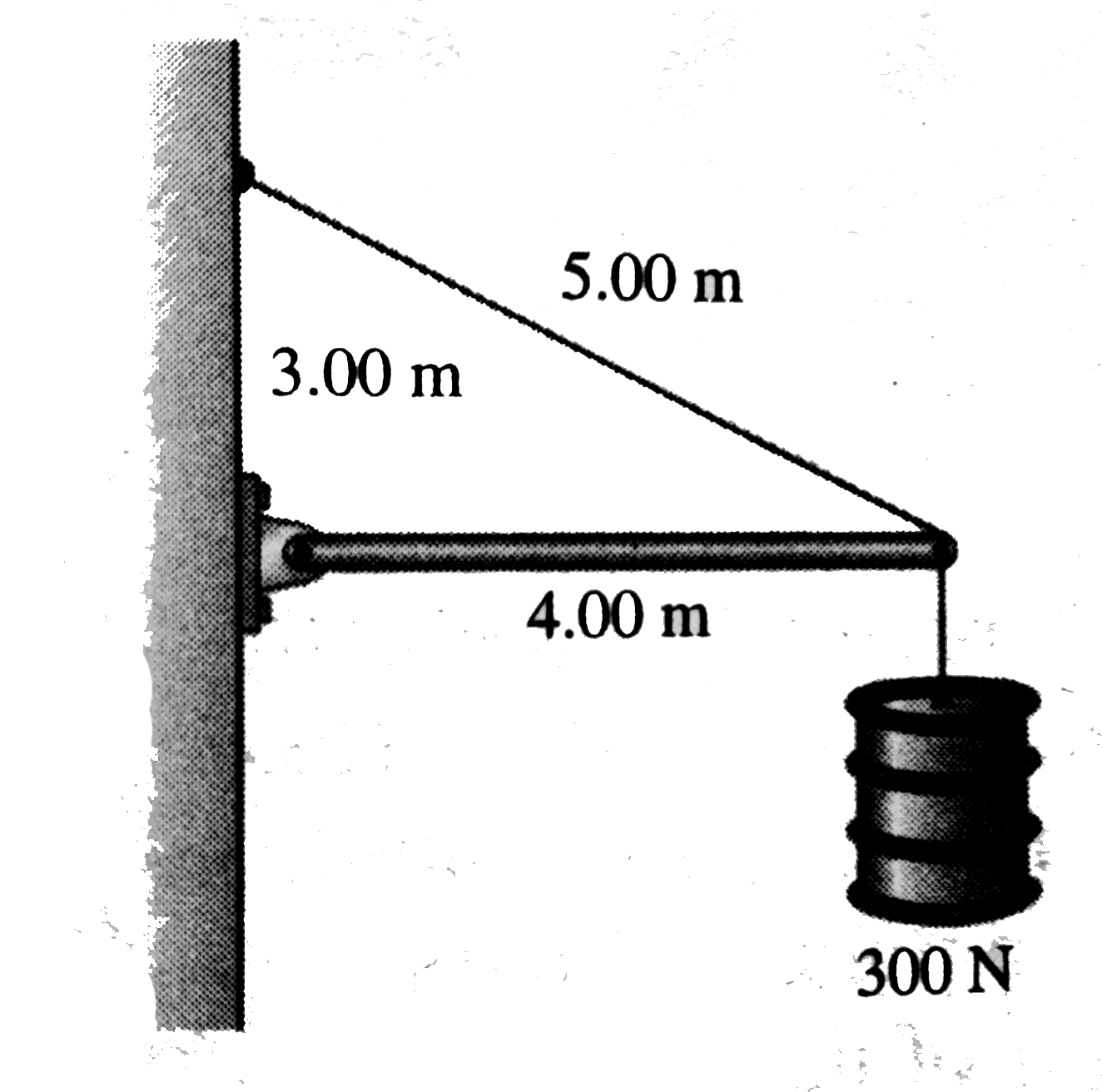
The tension in the cable00:57View SolutionThe horizontal beam in figure weighs `150 N`, and its centre of gravity is at its centre. Find
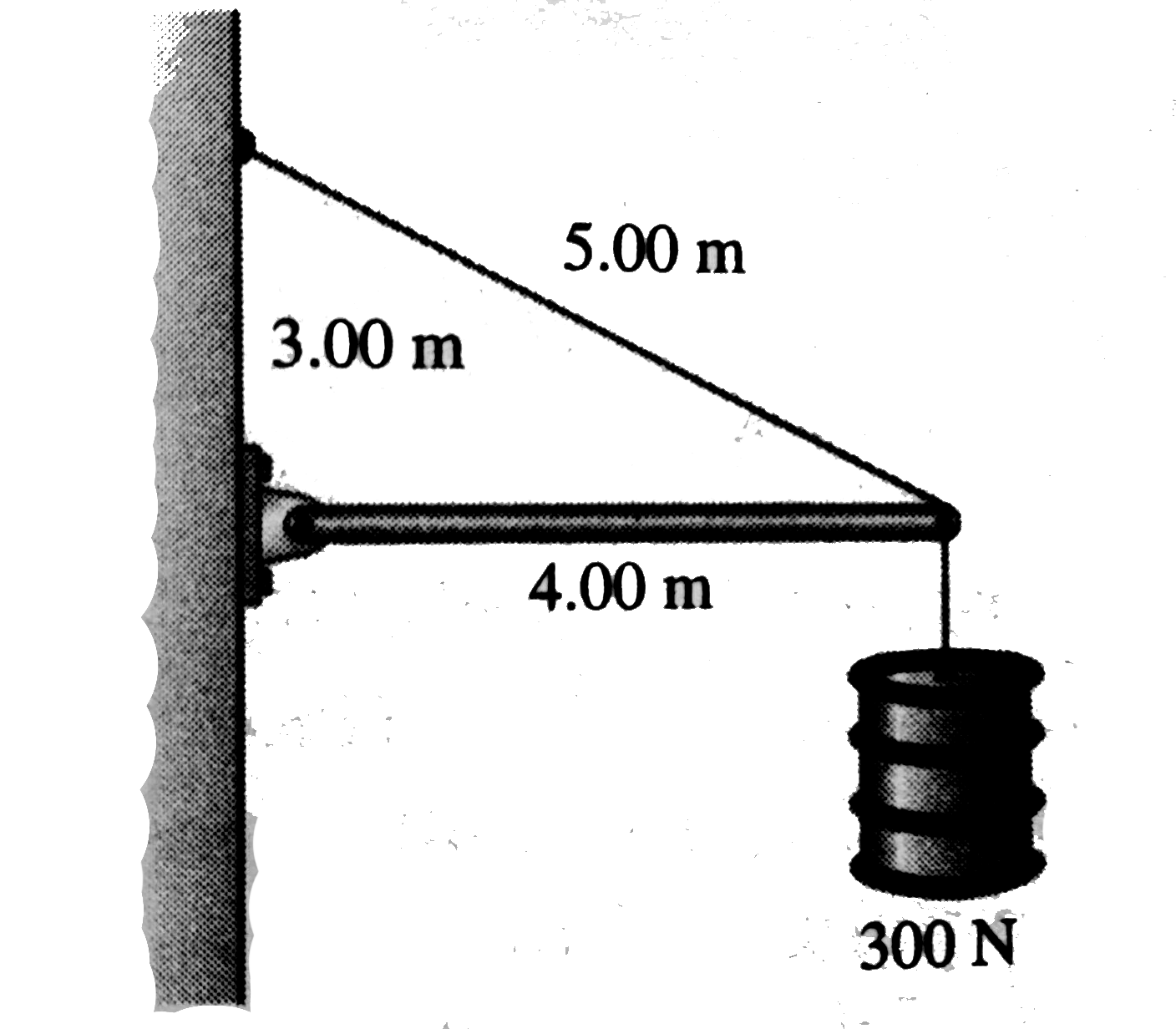
The horizontal and vertical components of the force exerted on the beam at the wall,05:22View SolutionA uniform ladder `5.0 m` long rests against a frictionless, vertical wall with its lower end `3.0m` to from the wall. The ladder weighs `160 N`. The coefficient of static friction between the foot of the ladder and the ground is `0.40`. A man weighing `740 N` climbs slowly up the ladder.
What is the actual frictional force when the man has climbed `1.0 m` along the ladder?08:04View SolutionA uniform ladder `5.0 m` long rests against a frictionless, vertical wall with its lower end `3.0m` to from the wall. The ladder weighs `160 N`. The coefficient of static friction between the foot of the ladder and the ground is `0.40`. A man weighing `740 N` climbs slowly up the ladder.
What is the actual frictional force when the man has climbed `1.0 m` along the ladder?08:04View SolutionA uniform ladder `5.0 m` long rests against a frictionless, vertical wall with its lower end `3.0m` to from the wall. The ladder weighs `160 N`. The coefficient of static friction between the foot of the ladder and the ground is `0.40`. A man weighing `740 N` climbs slowly up the ladder.
What is the actual frictional force when the man has climbed `1.0 m` along the ladder?08:04View SolutionA disc of radius R rolls without slipping at spped v along positve x-axis. Velocity of point P at the instant shown in figure is
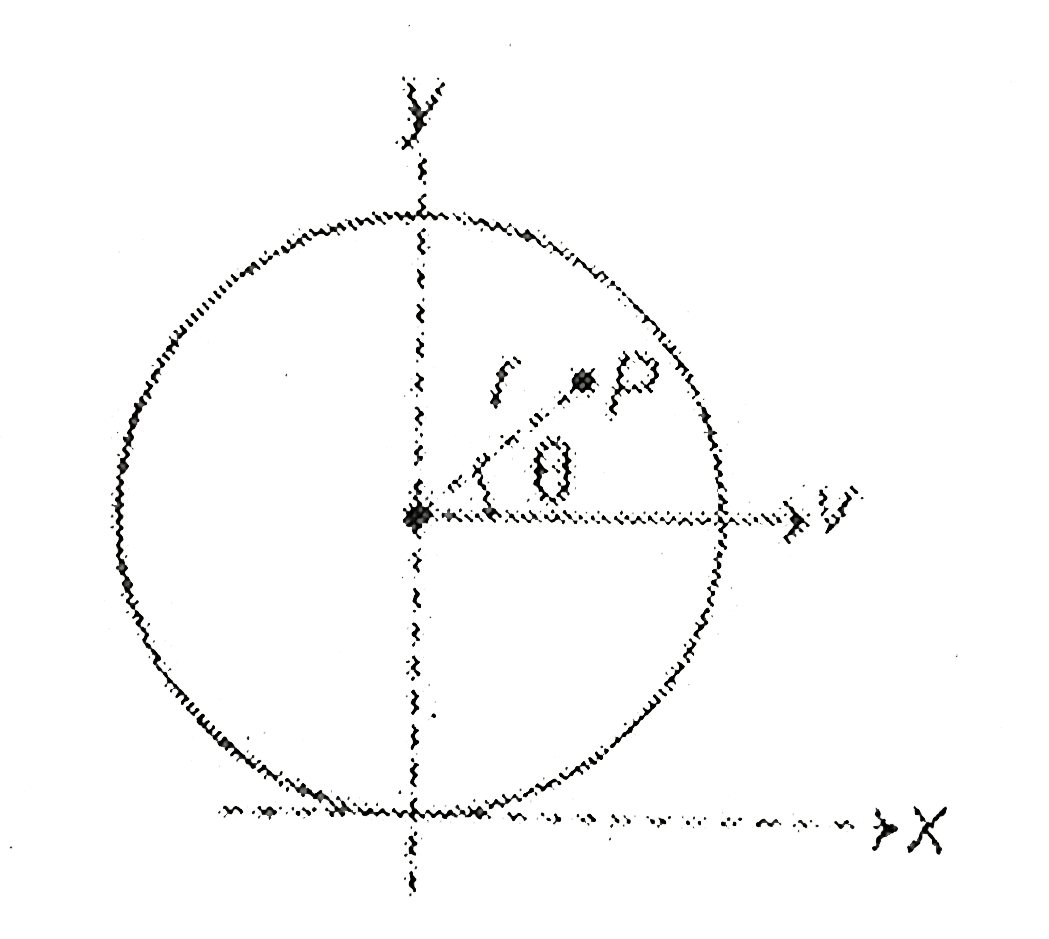 03:32View Solution
03:32View SolutionA disc having radius `R` is rolling without slipping on a horizontal (`x-z`) plane. Centre of the disc has a velocity ` v` and acceleration `a` as shown.

If `v=sqrt(2aR)` the angle `theta` between acceleration of the top most point and the horizontal is02:24View Solution
Linked Comprehension questions and complete solutions for chapter RIGID BODY DYNAMICS 1 of CENGAGE PHYSICS (ENGLISH) of Class 11
